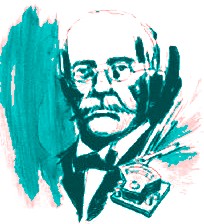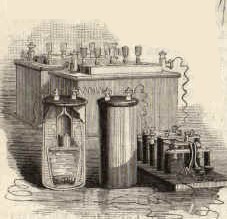Edward Weston (1850-1936)
 Edward Weston was born in Oswestry,
Shropshire (England), in 1850 and brought up in Wales. His father was an unsuccessful
merchant, and mother was a novelist, as well as a magazine writer. Edward Weston
attended the Adams School. He studied medicine at the insistence of his parents
and began his career as apprentice to a local physician where he developed an interest
in chemistry. However, after receiving his medical diploma in 1870, he went to America,
New York City, at the age of 20.
Edward Weston was born in Oswestry,
Shropshire (England), in 1850 and brought up in Wales. His father was an unsuccessful
merchant, and mother was a novelist, as well as a magazine writer. Edward Weston
attended the Adams School. He studied medicine at the insistence of his parents
and began his career as apprentice to a local physician where he developed an interest
in chemistry. However, after receiving his medical diploma in 1870, he went to America,
New York City, at the age of 20.
Weston found a job in the electroplating industry, and made many improvements in the processes used. During the first eighteen months in America, he revolutionized the Electro-plating industry. He realized that a constant source of current was required for quality plating, and the batteries used at the time were not sufficient for the job. Frustration with inadequate electricity supplies led to an obsession with power generation. In 1876 he patented for a dc generator. One of Weston's dynamos, running electric arc lamps, was shown at the Centennial Exposition in Philadelphia in 1876, but it received little attention. Shortly after this, Weston was contacted by Frederick Stevens, who offered Weston the opportunity to set up a dynamo division of his Steven, Roberts & Havell company. In 1877 the division was organized as a separate company, the Weston Dynamo Machine Company, in Newark, New Jersey, - the first US factory of it's kind.
Frustration with inadequate electricity supplies
led to an obsession with power generation. In 1876 he patented a design for a dc
generator. One of Weston's dynamos, running electric arc lamps, was shown at the
Centennial Exposition in Philadelphia in 1876, but it received little attention.
Shortly after this, Weston was contacted by Frederick Stevens, who offered Weston
the opportunity to set up a dynamo division of his Steven, Roberts & Havell company.
In 1877 the division was organized as a separate company, the Weston Dynamo Machine
Company, in Newark, New Jersey, - the first US factory of it's kind. To expand the
market, he began making generators for arc lighting. Inevitably, innovations and
improvements to the lamps themselves followed and, due to its success, the company
changed its name to the Weston Electric Light Company, going on to win the contract
to illuminate the new Brooklyn Bridge. At the same time, independent of Edison and
others, Weston was experimenting with incandescent light. Using his knowledge of
chemistry, electricity and mechanical engineering he designed a carbon filament
of unprecedented uniformity and longevity, subsequently used in all incandescent
lights until the introduction of tungsten 25 years later.
Weston invented and patented the saturated cadmium cell in 1893:
Cd(Hg) | CdSO4(aq), Hg2SO4 | Hg
It had the advantage of being less temperature sensitive than the previous standard, the Clark cell. It also had the advantage of producing a voltage very near to one volt: 1.0183 V. In 1911 the Weston Saturated Cadmium Cell became the International Standard for electromotive force. Weston waved his patent rights shortly afterward so anyone was allowed to manufacture it.

Connect with us
Contact us today